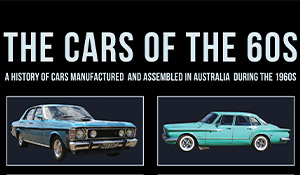From family sedans to Supercars
Fifty-seven years ago at the Gnoo Blas circuit near Orange in New South Wales, the dapper doyen of Australian motoring journalists, David McKay, crossed the line to win the inaugural Australian Touring Car Championship, starting something very big.
That one-race Cup marked the first time that hotted-up family cars were legitimized with their own championship. That 1960 race started a tradition that would capture the imagination of a nation and begin the tribal rivalry that now drives the Australian Supercar Championship.
Pre Historics
Sedans had been raced since the early ’50s, often in “run what yer brung” butcher’s picnic events, or lumped in with sports cars in GT and Production races, and increasingly, in hotly contested races of their own. The most popular mounts in those early days were the 48-215 and FJ Holden. On that February day in 1960 when McKay triumphed, a fleet of eight Humpies chased the leading 3.4 litre Jaguars of McKay, Bill Pitt and Ron Hodgson into motoring racing history. Behind them trailed Austin Lancers and Morris Majors, two Simca Arondes, a Peugeot 203, and a lone NSU Prinz.
Decade of Change
The sixties was a decade of massive change, and Australian motor racing, particularly touring cars, changed fast, too. The newly formed Appendix J racing category (named after its section in the rule book) saw the revolutionary Mini, the basic-but-fast Ford Cortina variants and the tough, home grown EH Holden challenge the Jaguars.
By mid-decade, ‘light’ often beat ‘might’. Today, these cars are represented by the pre-65 Group Nb Historic Touring Cars.
But halfway through the ’60s, the game changed big time. In December, 1964, a Ford Mustang competed in Australia for the first time. By early 1965, if you didn’t drive a Mustang, you simply weren’t in the hunt.
From then until the end of 1972, Improved Touring Cars, as the series was now called, was dominated by V8s. The big gun Mustangs of legends like Moffat, Geoghegan and Jane would be eventually beaten to the championship by Norm Beechey’s Monaro, while the 2.2 litre Porsche 911S (deemed a touring car because it had a “back seat”) led the smaller challenge group, along with Ford Escorts, Alfa Romeos and Minis. You’ll see these cars in the pre-72 Group Nc Historic Touring Cars.
Series Production emerges
However, throughout the ‘60s, a parallel series had been running. The Armstrong 500 for Series Production cars, or Group E, began at Phillip Island before moving to Bathurst. These annual enduros for (supposedly) stock showroom cars - with classes based on the vehicle’s retail price rather than capacity - became very popular with manufacturers, as well as the public.
As they came to realise that what won on Sunday sold on Monday, the Big Three - Holden, Ford and Chrysler - engineered their ‘Bathurst Specials’. Holden began with the Monaro, then went the nimble route with the Torana. Ford went for brawn with the mighty Falcon GT and GT-HO variants, while Chrysler started with the Pacer and ended with the Charger.
Series Production races became a feature of race meetings everywhere, with hotter versions of these cars also competing in Improved Touring.
In 1973, the rules changed again. Series Production and Improved Touring blended into Group C; a blanket touring car formula that ran until the introduction of the “global” Group A category in 1985. This format, which saw cars from around the world race on Australian soil, became the Holden-Ford two horse race from 1992 that was eventually named V8 Supercars.
Aussie Success
Once the poor cousin of “proper racing cars”, touring car racing has become Australia’s premier formula - our Formula 1.
Even before his passing in 2004, David McKay, the gentleman amateur who formed Australia’s first professional motor racing team, Scuderia Veloce (the equipe that raced open wheelers, sports and touring cars), would have been amazed to see family sedan car racing grow to become the mega-million-dollar business that sit is today.






















